-
AuthorSearch Results
-
December 13, 2021 at 3:06 pm #6228
In reply to: The Elusive Samuel Housley and Other Family Stories
Francis Purdy: The Beggarlea Bulldog and Primitive Methodist Preacher
Francis Purdy was my great great grandfather. We did not know anything about the Primitive Methodists prior to this family research project, but my mother had another look through the family souvenirs and photographs and found a little book dated 1913, by William Purdy called: The History of The Primitive Methodists of Langley, Heanor, Derbyshire and District. Practical remarks on Sunday school work and a biography of the late Francis Purdy, an early local preacher. Printed by GC Brittain and sons. William Purdy was Francis son, and George’s brother.
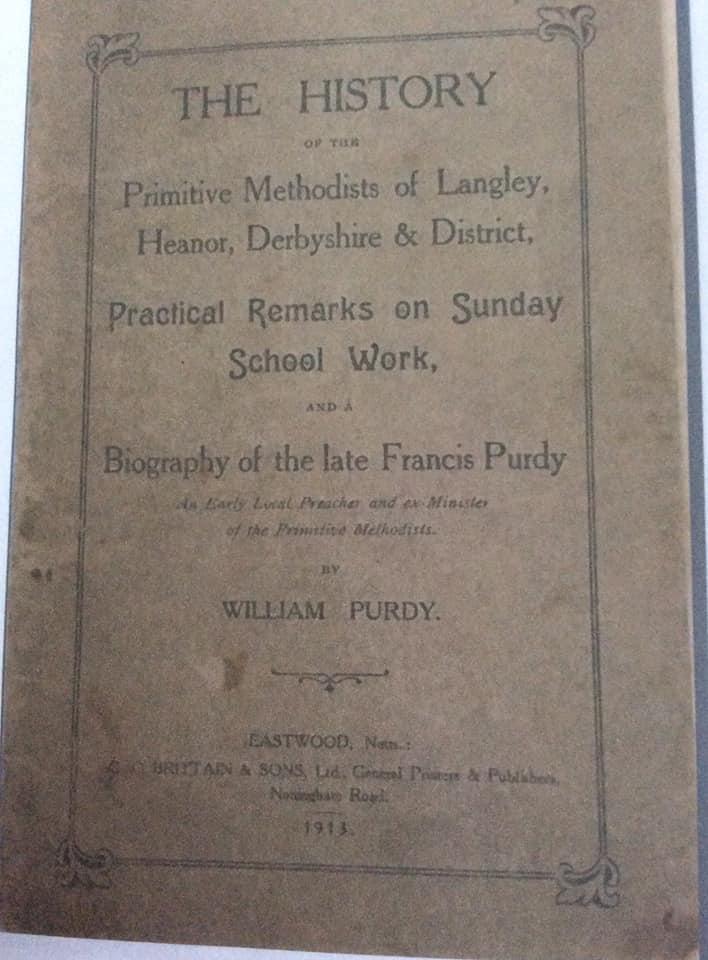
Francis Purdy:
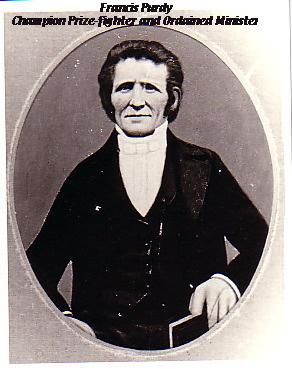
The following can be found online from various sources but I am unable to find the original source to credit with this information:
“In spite of having pious parents, Francis was a great prize-fighter and owner of champion dogs. He was known as the Beggarlee Bulldog, and fought many pitched battles. It was in 1823 that he fought on Nottingham Forest for the championship of three counties. After the fight going eleven rounds, which continued one hour and twenty minutes, he was declared victorious.”
The Primitive Methodists under the Rev Richard Whitechurch began a regular mission in Beggarlee. The locals tried to dismiss the Methodist “Ranters” by the use of intimidating tactics. Francis was prepared to release his fighting dogs during their prayer meeting, but became so interested in their faith that he instead joined them. The Methodist Church wrote: ”A strong feeling came over him, while his mates incited him to slip his dogs from the leads. He refused, and decided to return home. After concealing himself in a dyke, to listen to the Missioners on the following Sunday, he stole into the house of a Mrs Church, where a service was being held. Shortly after this, a society was formed with Francis Purdy as leader, and he was also the superintendent of the first Sunday School. After a short spell as local preacher at Beauvale, Tag Hill, Awsworth, Kimberly, Brinsley, etc., Mr Francis Purdy was ordained a minister by the Rev. Thomas King, of Nottingham, on the 17th December, 1827.”
December 13, 2021 at 2:34 pm #6227In reply to: The Elusive Samuel Housley and Other Family Stories
The Scottish Connection
My grandfather always used to say we had some Scottish blood because his “mother was a Purdy”, and that they were from the low counties of Scotland near to the English border.
My mother had a Scottish hat in among the boxes of souvenirs and old photographs. In one of her recent house moves, she finally threw it away, not knowing why we had it or where it came from, and of course has since regretted it! It probably came from one of her aunts, either Phyllis or Dorothy. Neither of them had children, and they both died in 1983. My grandfather was executor of the estate in both cases, and it’s assumed that the portraits, the many photographs, the booklet on Primitive Methodists, and the Scottish hat, all relating to his mother’s side of the family, came into his possession then. His sister Phyllis never married and was living in her parents home until she died, and is the likeliest candidate for the keeper of the family souvenirs.
Catherine Housley married George Purdy, and his father was Francis Purdy, the Primitive Methodist preacher. William Purdy was the father of Francis.
Record searches find William Purdy was born on 16 July 1767 in Carluke, Lanarkshire, near Glasgow in Scotland. He worked for James Watt, the inventor of the steam engine, and moved to Derbyshire for the purpose of installing steam driven pumps to remove the water from the collieries in the area.
Another descendant of Francis Purdy found the following in a book in a library in Eastwood:
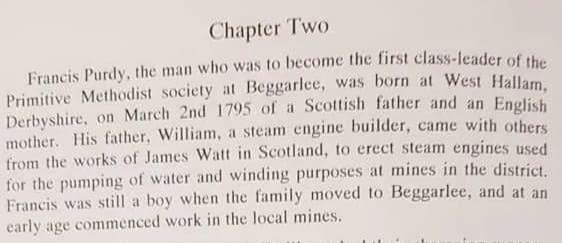
William married a local girl, Ruth Clarke, in Duffield in Derbyshire in 1786. William and Ruth had nine children, and the seventh was Francis who was born at West Hallam in 1795.
Perhaps the Scottish hat came from William Purdy, but there is another story of Scottish connections in Smalley: Bonnie Prince Charlie and the Jacobite Rebellion of 1745. Although the Purdy’s were not from Smalley, Catherine Housley was.
From an article on the Heanor and District Local History Society website:
The Jacobites in Smalley
Few people would readily associate the village of Smalley, situated about two miles west of Heanor, with Bonnie Prince Charlie and the Jacobite Rebellion of 1745 – but there is a clear link.
During the winter of 1745, Charles Edward Stuart, the “Bonnie Prince” or “The Young Pretender”, marched south from Scotland. His troops reached Derby on 4 December, and looted the town, staying for two days before they commenced a fateful retreat as the Duke of Cumberland’s army approached.
While staying in Derby, or during the retreat, some of the Jacobites are said to have visited some of the nearby villages, including Smalley.
A history of the local aspects of this escapade was written in 1933 by L. Eardley-Simpson, entitled “Derby and the ‘45,” from which the following is an extract:
“The presence of a party at Smalley is attested by several local traditions and relics. Not long ago there were people living who remember to have seen at least a dozen old pikes in a room adjoining the stables at Smalley Hall, and these were stated to have been left by a party of Highlanders who came to exchange their ponies for horses belonging to the then owner, Mrs Richardson; in 1907, one of these pikes still remained. Another resident of Smalley had a claymore which was alleged to have been found on Drumhill, Breadsall Moor, while the writer of the History of Smalley himself (Reverend C. Kerry) had a magnificent Andrew Ferrara, with a guard of finely wrought iron, engraved with two heads in Tudor helmets, of the same style, he states, as the one left at Wingfield Manor, though why the outlying bands of Army should have gone so far afield, he omits to mention. Smalley is also mentioned in another strange story as to the origin of the family of Woolley of Collingham who attained more wealth and a better position in the world than some of their relatives. The story is to the effect that when the Scots who had visited Mrs Richardson’s stables were returning to Derby, they fell in with one Woolley of Smalley, a coal carrier, and impressed him with horse and cart for the conveyance of certain heavy baggage. On the retreat, the party with Woolley was surprised by some of the Elector’s troopers (the Royal army) who pursued the Scots, leaving Woolley to shift for himself. This he did, and, his suspicion that the baggage he was carrying was part of the Prince’s treasure turning out to be correct, he retired to Collingham, and spent the rest of his life there in the enjoyment of his luckily acquired gains. Another story of a similar sort was designed to explain the rise of the well-known Derbyshire family of Cox of Brailsford, but the dates by no means agree with the family pedigree, and in any event the suggestion – for it is little more – is entirely at variance with the views as to the rights of the Royal House of Stuart which were expressed by certain members of the Cox family who were alive not many years ago.”
A letter from Charles Kerry, dated 30 July 1903, narrates another strange twist to the tale. When the Highlanders turned up in Smalley, a large crowd, mainly women, gathered. “On a command in Gaelic, the regiment stooped, and throwing their kilts over their backs revealed to the astonished ladies and all what modesty is careful to conceal. Father, who told me, said they were not any more troubled with crowds of women.”
Folklore or fact? We are unlikely to know, but the Scottish artefacts in the Smalley area certainly suggest that some of the story is based on fact.
We are unlikely to know where that Scottish hat came from, but we did find the Scottish connection. William Purdy’s mother was Grizel Gibson, and her mother was Grizel Murray, both of Lanarkshire in Scotland. The name Grizel is a Scottish form of the name Griselda, and means “grey battle maiden”. But with the exception of the name Murray, The Purdy and Gibson names are not traditionally Scottish, so there is not much of a Scottish connection after all. But the mystery of the Scottish hat remains unsolved.
December 13, 2021 at 12:17 pm #6224In reply to: The Elusive Samuel Housley and Other Family Stories
The Woman in the Portrait: Catherine Housley’s Mother
“The One I Ruined”I was living in England at the time of my great aunts deaths in 1983, both Dorothy Tooby and Phyllis Marshall, when this portrait came to be in my possession via their brother, my grandfather George Marshall. There was some damage on the mouth. I mentioned it at work and my boss said he had a friend who could fix it, but when I eventually got it back it was much worse. Since then, this portrait has been known as “the one I ruined”.
This picture remains a mystery, even though we know her name now. She appears to be in mourning. She doesn’t appear to be too poor, or unhealthy. And yet Elizabeth died at just thirty years of age of TB and her children were in the workhouse a year later.
On closer inspection, the portrait could be a photograph that has been painted over, but it’s considerably larger than any of the usual photographs of the time. Is there a possibility that the picture was made later, after her death, in memory of her? This seems to be the likeliest explanation.
December 13, 2021 at 11:58 am #6223In reply to: The Elusive Samuel Housley and Other Family Stories
Kate Purdy and the DH Lawrence Connection
Catherine (Kate) Purdy 1874-1950 was my grandfather George Marshall’s aunt, and the mother of George Rushby who went to Africa. The photo is one of our family photos, and we knew that the woman at the back third from the right was an aunt of my grandfather’s. We didn’t know that it was Kate until we saw other photos of her in Mike’s collection.
DH Lawrence was born in Eastwood at roughly the same time as my great grandmother Mary Ann Gilman Purdy. Apparently his books are based on actual people living in the area at the time, so I read as many of his books as I could find, to help paint the picture of the time and place. I also found out via an Eastwood facebook group, that he was not well liked there, and still isn’t. They say he was a wife beater, a groper and was cruel to animals, and they did not want a statue of him in their town!
Kate Rushby third from right back row:
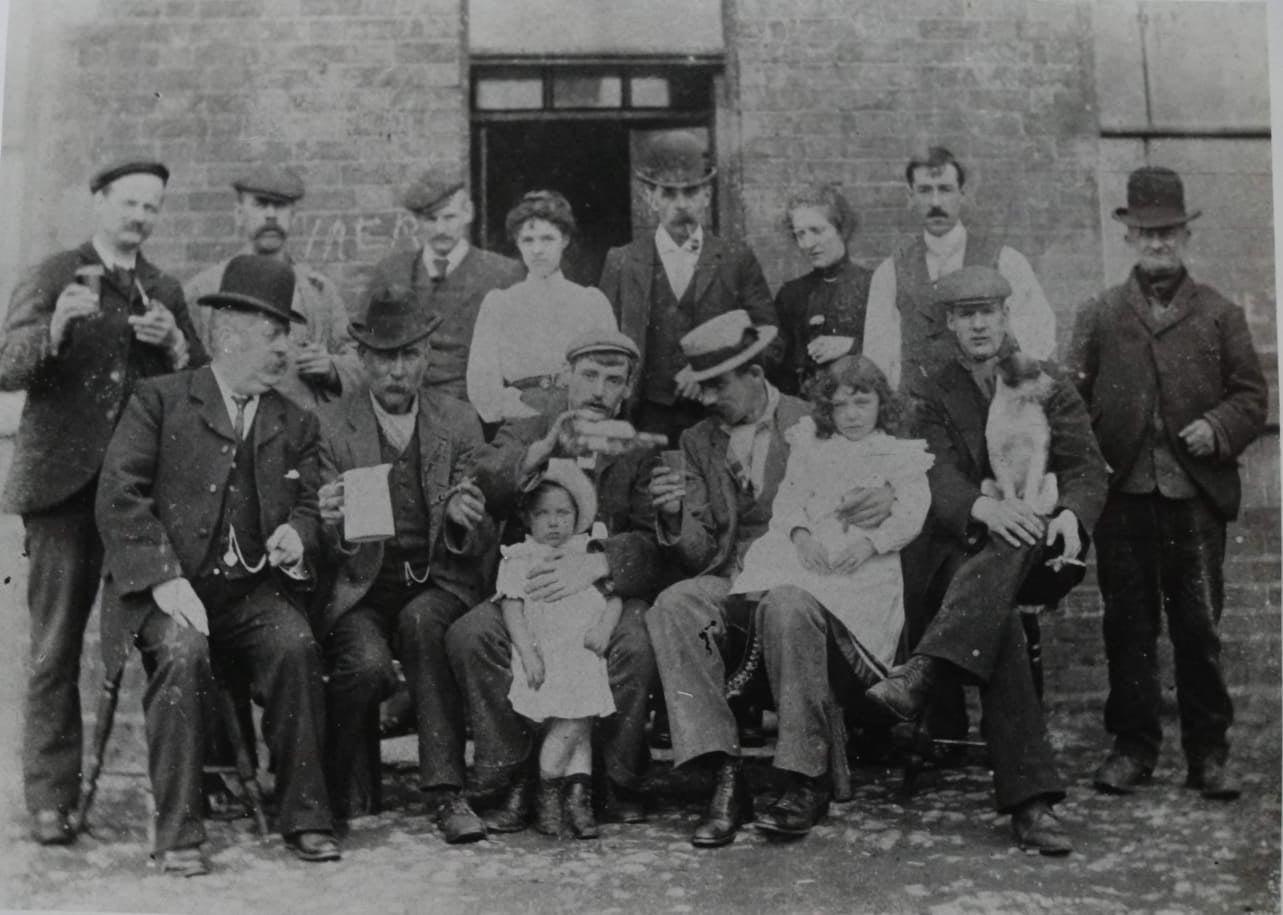
Kate Rushby’s story as told by her grandson Mike:
George’s daughter Catherine (Kate) Purdy grew up in Eastwood and was living at Walnut Tree Lane when, at the age of 21, and on the 24 Sep 1894, she married John Henry Payling Rushby who was a policeman in the Grimsby Police. John Henry left the Police and together they bought a public house “The Three Tuns Inn” at Beggarlee. The establishment was frequented by amongst others, the writer D.H.Lawrence who wrote much of his book “Sons and Lovers” in the Inn. In his book he calls the Inn “The Moon and Stars” and mentions Kate. though not by name.
John Henry Rushby had two children, Charlotte and George Gilman Rushby. But a year after the birth of George on 28 Feb 1900, John Henry died at the age of thirty on 13 Sep 1901. He liked to show off his strength to his friends by lifting above his head an oak barrel full of beer. This would have weighed almost 200 kilograms. “He bust his gut” Kate said. He died of peritonitis following a hernia.
Following the death of John Henry, Kate managed the Three Tuns Inn on her own. But a regular visitor to the Inn was Frank Freer who was a singer and used to entertain the patrons with his fine baritone voice and by playing the cornet. He and Kate got married, but he turned out to be a drunk who beat his wife and was cruel to her son. They separated and he died from alcoholism, though he may also have been struck on the head with a beer bottle by a person unknown. She then married Mr Gregory Simpson who fathered a daughter Catherine, and then died from gas injuries he suffered on the battlefield in the first world war.
Despite her lack of men able to stay the course, Catherine became a very successful business woman. She ran the Three Tuns Inn and later moved to Jacksdale where she owned ”ThePortland Arms Hotel”. She travelled extensively to Europe in times of peace, to Africa several times, and around England frequently. She settled in Selston Lane Jacksdale in a large house bracketed by the homes of her daughters Lottie and Cath. She was a strong and tenacious woman who became the surrogate mother of her grandchildren Ann and George when they were separated from their parents by the second world war.
Mike Rushby’s photo of Kate:
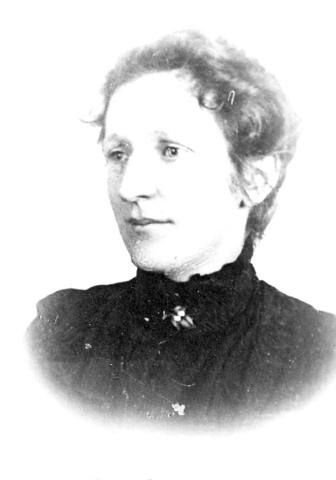 December 13, 2021 at 11:29 am #6222
December 13, 2021 at 11:29 am #6222In reply to: The Elusive Samuel Housley and Other Family Stories
George Gilman Rushby: The Cousin Who Went To Africa
The portrait of the woman has “mother of Catherine Housley, Smalley” written on the back, and one of the family photographs has “Francis Purdy” written on the back. My first internet search was “Catherine Housley Smalley Francis Purdy”. Easily found was the family tree of George (Mike) Rushby, on one of the genealogy websites. It seemed that it must be our family, but the African lion hunter seemed unlikely until my mother recalled her father had said that he had a cousin who went to Africa. I also noticed that the lion hunter’s middle name was Gilman ~ the name that Catherine Housley’s daughter ~ my great grandmother, Mary Ann Gilman Purdy ~ adopted, from her aunt and uncle who brought her up.
I tried to contact George (Mike) Rushby via the ancestry website, but got no reply. I searched for his name on Facebook and found a photo of a wildfire in a place called Wardell, in Australia, and he was credited with taking the photograph. A comment on the photo, which was a few years old, got no response, so I found a Wardell Community group on Facebook, and joined it. A very small place, population some 700 or so, and I had an immediate response on the group to my question. They knew Mike, exchanged messages, and we were able to start emailing. I was in the chair at the dentist having an exceptionally long canine root canal at the time that I got the message with his email address, and at that moment the song Down in Africa started playing.
Mike said it was clever of me to track him down which amused me, coming from the son of an elephant and lion hunter. He didn’t know why his father’s middle name was Gilman, and was not aware that Catherine Housley’s sister married a Gilman.
Mike Rushby kindly gave me permission to include his family history research in my book. This is the story of my grandfather George Marshall’s cousin. A detailed account of George Gilman Rushby’s years in Africa can be found in another chapter called From Tanganyika With Love; the letters Eleanor wrote to her family.
George Gilman Rushby:
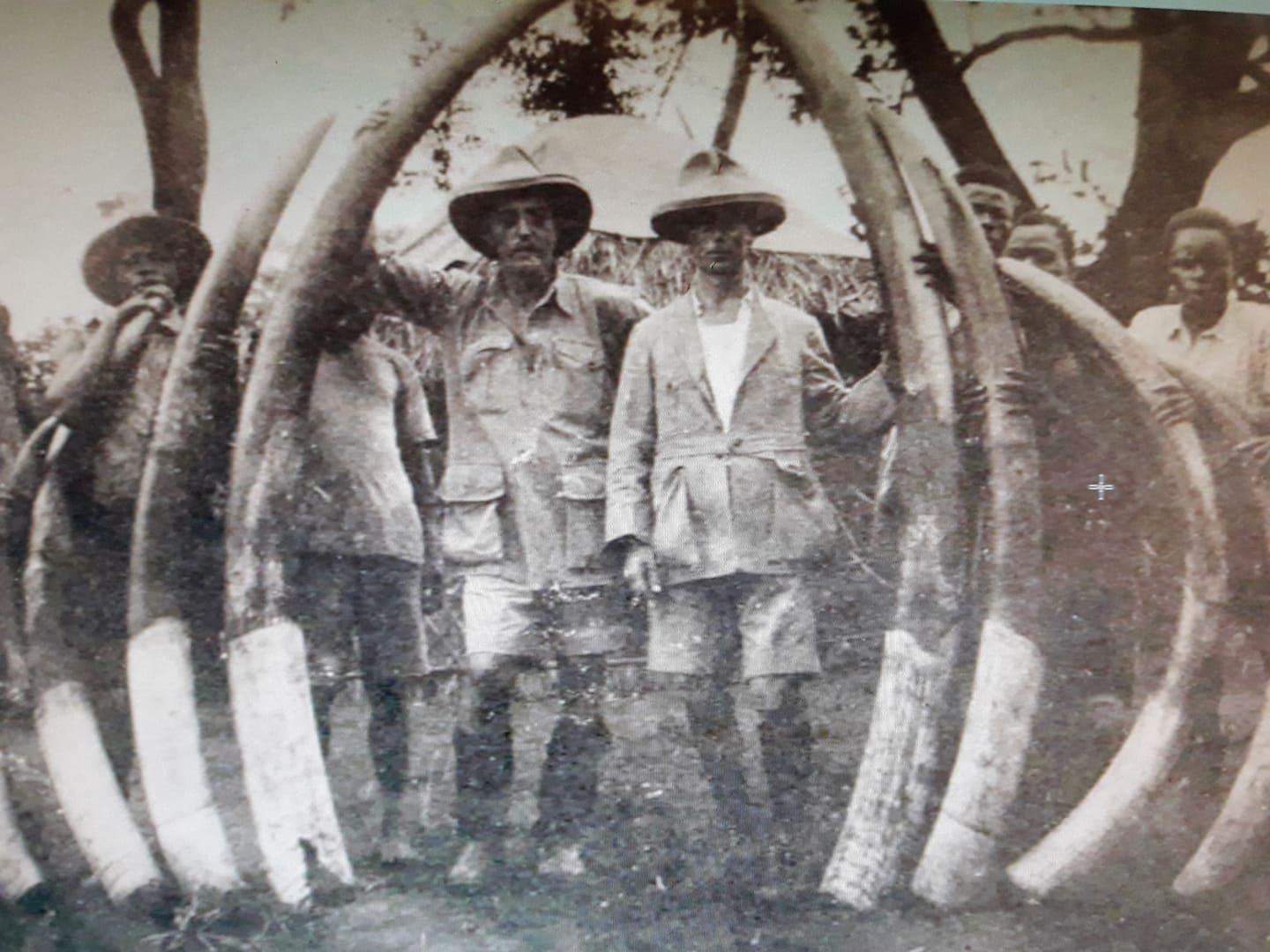
The story of George Gilman Rushby 1900-1969, as told by his son Mike:
George Gilman Rushby:
Elephant hunter,poacher, prospector, farmer, forestry officer, game ranger, husband to Eleanor, and father of 6 children who now live around the world.George Gilman Rushby was born in Nottingham on 28 Feb 1900 the son of Catherine Purdy and John Henry Payling Rushby. But John Henry died when his son was only one and a half years old, and George shunned his drunken bullying stepfather Frank Freer and was brought up by Gypsies who taught him how to fight and took him on regular poaching trips. His love of adventure and his ability to hunt were nurtured at an early stage of his life.
The family moved to Eastwood, where his mother Catherine owned and managed The Three Tuns Inn, but when his stepfather died in mysterious circumstances, his mother married a wealthy bookmaker named Gregory Simpson. He could afford to send George to Worksop College and to Rugby School. This was excellent schooling for George, but the boarding school environment, and the lack of a stable home life, contributed to his desire to go out in the world and do his own thing. When he finished school his first job was as a trainee electrician with Oaks & Co at Pye Bridge. He also worked part time as a motor cycle mechanic and as a professional boxer to raise the money for a voyage to South Africa.In May 1920 George arrived in Durban destitute and, like many others, living on the beach and dependant upon the Salvation Army for a daily meal. However he soon got work as an electrical mechanic, and after a couple of months had earned enough money to make the next move North. He went to Lourenco Marques where he was appointed shift engineer for the town’s power station. However he was still restless and left the comfort of Lourenco Marques for Beira in August 1921.
Beira was the start point of the new railway being built from the coast to Nyasaland. George became a professional hunter providing essential meat for the gangs of construction workers building the railway. He was a self employed contractor with his own support crew of African men and began to build up a satisfactory business. However, following an incident where he had to shoot and kill a man who attacked him with a spear in middle of the night whilst he was sleeping, George left the lower Zambezi and took a paddle steamer to Nyasaland (Malawi). On his arrival in Karongo he was encouraged to shoot elephant which had reached plague proportions in the area – wrecking African homes and crops, and threatening the lives of those who opposed them.
His next move was to travel by canoe the five hundred kilometre length of Lake Nyasa to Tanganyika, where he hunted for a while in the Lake Rukwa area, before walking through Northern Rhodesia (Zambia) to the Congo. Hunting his way he overachieved his quota of ivory resulting in his being charged with trespass, the confiscation of his rifles, and a fine of one thousand francs. He hunted his way through the Congo to Leopoldville then on to the Portuguese enclave, near the mouth of the mighty river, where he worked as a barman in a rough and tough bar until he received a message that his old friend Lumb had found gold at Lupa near Chunya. George set sail on the next boat for Antwerp in Belgium, then crossed to England and spent a few weeks with his family in Jacksdale before returning by sea to Dar es Salaam. Arriving at the gold fields he pegged his claim and almost immediately went down with blackwater fever – an illness that used to kill three out of four within a week.
When he recovered from his fever, George exchanged his gold lease for a double barrelled .577 elephant rifle and took out a special elephant control licence with the Tanganyika Government. He then headed for the Congo again and poached elephant in Northern Rhodesia from a base in the Congo. He was known by the Africans as “iNyathi”, or the Buffalo, because he was the most dangerous in the long grass. After a profitable hunting expedition in his favourite hunting ground of the Kilombera River he returned to the Congo via Dar es Salaam and Mombassa. He was after the Kabalo district elephant, but hunting was restricted, so he set up his base in The Central African Republic at a place called Obo on the Congo tributary named the M’bomu River. From there he could make poaching raids into the Congo and the Upper Nile regions of the Sudan. He hunted there for two and a half years. He seldom came across other Europeans; hunters kept their own districts and guarded their own territories. But they respected one another and he made good and lasting friendships with members of that small select band of adventurers.
Leaving for Europe via the Congo, George enjoyed a short holiday in Jacksdale with his mother. On his return trip to East Africa he met his future bride in Cape Town. She was 24 year old Eleanor Dunbar Leslie; a high school teacher and daughter of a magistrate who spent her spare time mountaineering, racing ocean yachts, and riding horses. After a whirlwind romance, they were betrothed within 36 hours.
On 25 July 1930 George landed back in Dar es Salaam. He went directly to the Mbeya district to find a home. For one hundred pounds he purchased the Waizneker’s farm on the banks of the Mntshewe Stream. Eleanor, who had been delayed due to her contract as a teacher, followed in November. Her ship docked in Dar es Salaam on 7 Nov 1930, and they were married that day. At Mchewe Estate, their newly acquired farm, they lived in a tent whilst George with some help built their first home – a lovely mud-brick cottage with a thatched roof. George and Eleanor set about developing a coffee plantation out of a bush block. It was a very happy time for them. There was no electricity, no radio, and no telephone. Newspapers came from London every two months. There were a couple of neighbours within twenty miles, but visitors were seldom seen. The farm was a haven for wild life including snakes, monkeys and leopards. Eleanor had to go South all the way to Capetown for the birth of her first child Ann, but with the onset of civilisation, their first son George was born at a new German Mission hospital that had opened in Mbeya.
Occasionally George had to leave the farm in Eleanor’s care whilst he went off hunting to make his living. Having run the coffee plantation for five years with considerable establishment costs and as yet no return, George reluctantly started taking paying clients on hunting safaris as a “white hunter”. This was an occupation George didn’t enjoy. but it brought him an income in the days when social security didn’t exist. Taking wealthy clients on hunting trips to kill animals for trophies and for pleasure didn’t amuse George who hunted for a business and for a way of life. When one of George’s trackers was killed by a leopard that had been wounded by a careless client, George was particularly upset.
The coffee plantation was approaching the time of its first harvest when it was suddenly attacked by plagues of borer beetles and ring barking snails. At the same time severe hail storms shredded the crop. The pressure of the need for an income forced George back to the Lupa gold fields. He was unlucky in his gold discoveries, but luck came in a different form when he was offered a job with the Forestry Department. The offer had been made in recognition of his initiation and management of Tanganyika’s rainbow trout project. George spent most of his short time with the Forestry Department encouraging the indigenous people to conserve their native forests.In November 1938 he transferred to the Game Department as Ranger for the Eastern Province of Tanganyika, and over several years was based at Nzasa near Dar es Salaam, at the old German town of Morogoro, and at lovely Lyamungu on the slopes of Kilimanjaro. Then the call came for him to be transferred to Mbeya in the Southern Province for there was a serious problem in the Njombe district, and George was selected by the Department as the only man who could possibly fix the problem.
Over a period of several years, people were being attacked and killed by marauding man-eating lions. In the Wagingombe area alone 230 people were listed as having been killed. In the Njombe district, which covered an area about 200 km by 300 km some 1500 people had been killed. Not only was the rural population being decimated, but the morale of the survivors was so low, that many of them believed that the lions were not real. Many thought that evil witch doctors were controlling the lions, or that lion-men were changing form to kill their enemies. Indeed some wichdoctors took advantage of the disarray to settle scores and to kill for reward.
By hunting down and killing the man-eaters, and by showing the flesh and blood to the doubting tribes people, George was able to instil some confidence into the villagers. However the Africans attributed the return of peace and safety, not to the efforts of George Rushby, but to the reinstallation of their deposed chief Matamula Mangera who had previously been stood down for corruption. It was Matamula , in their eyes, who had called off the lions.
Soon after this adventure, George was appointed Deputy Game Warden for Tanganyika, and was based in Arusha. He retired in 1956 to the Njombe district where he developed a coffee plantation, and was one of the first in Tanganyika to plant tea as a major crop. However he sensed a swing in the political fortunes of his beloved Tanganyika, and so sold the plantation and settled in a cottage high on a hill overlooking the Navel Base at Simonstown in the Cape. It was whilst he was there that TV Bulpin wrote his biography “The Hunter is Death” and George wrote his book “No More The Tusker”. He died in the Cape, and his youngest son Henry scattered his ashes at the Southern most tip of Africa where the currents of the Atlantic and Indian Oceans meet .
George Gilman Rushby:
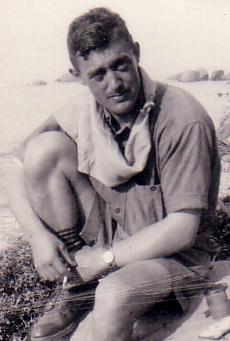 December 13, 2021 at 11:07 am #6221
December 13, 2021 at 11:07 am #6221In reply to: The Elusive Samuel Housley and Other Family Stories
Mary Ann Gilman Purdy
1880-1950
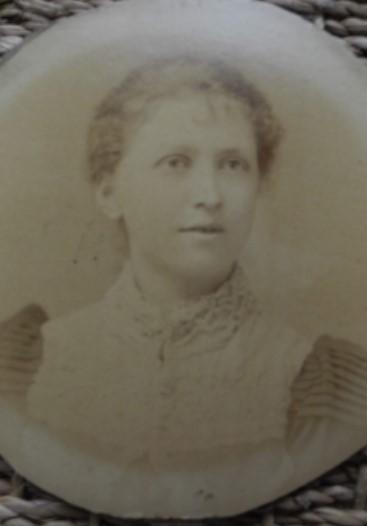
Mary Ann was my grandfather George Marshall’s mother. She died in 1950, seven years before I was born. She has been referred to more often than not, since her death, as Mary Ann Gilman Purdy, rather than Mary Marshall. She was from Buxton, so we believed, as was her husband William Marshall. There are family photos of the Gilmans, grocers in Buxton, and we knew that Mary Ann was brought up by them. My grandfather, her son, said that she thought very highly of the Gilman’s, and added the Gilman name to her birth name of Purdy.
The 1891 census in Buxton:

(Mary Ann’s aunt, Mrs Gilman, was also called Mary Anne, but spelled with an E.)
Samuel Gilman 1846-1909, and Mary Anne (Housley) Gilman 1846-1935, in Buxton:
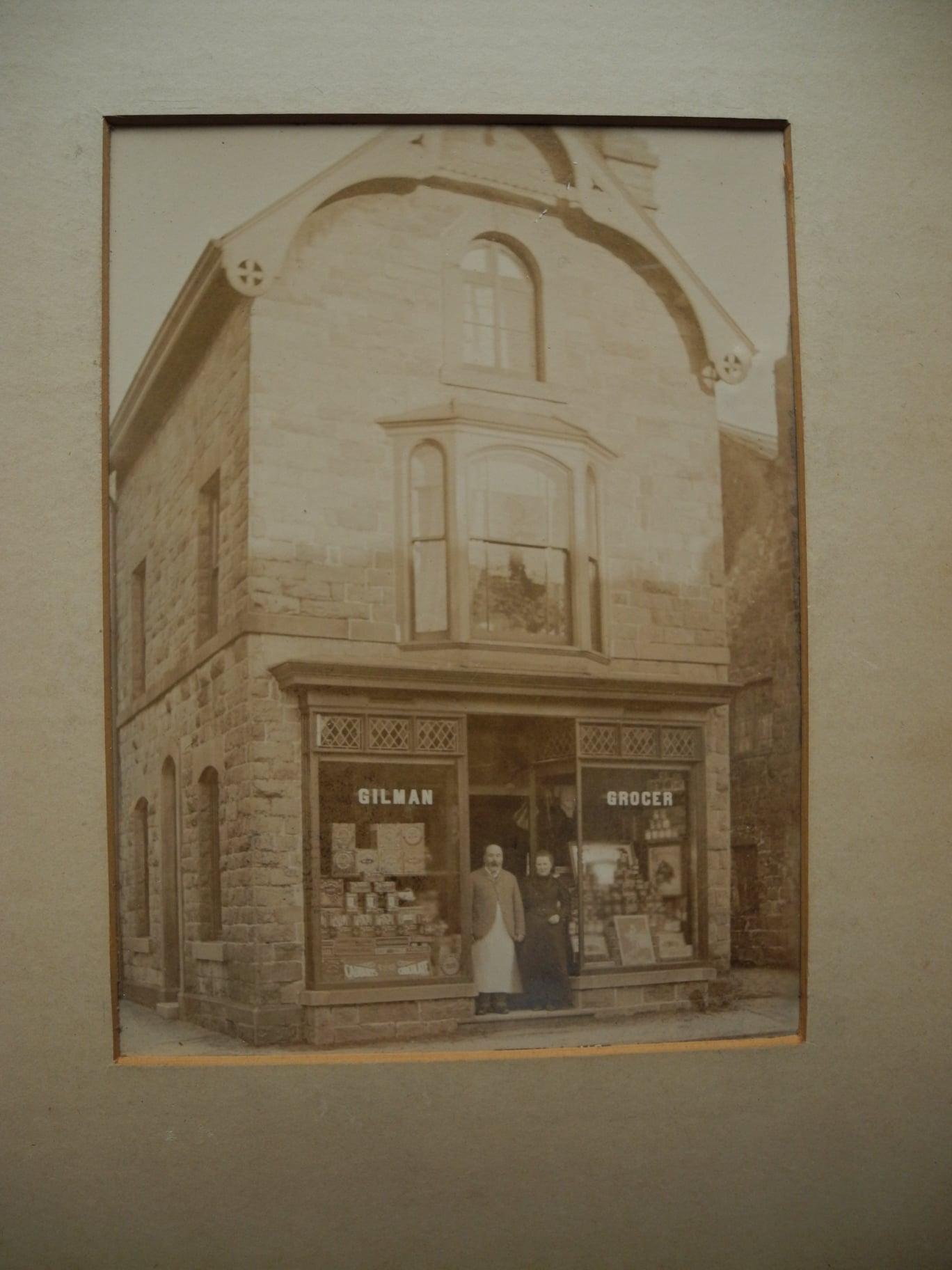
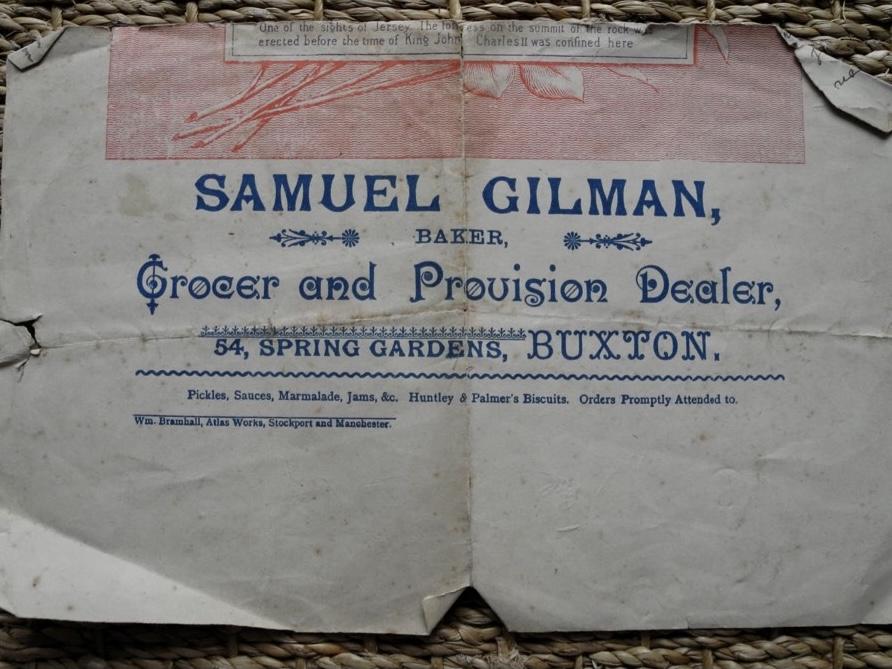
What we didn’t know was why Mary Ann (and her sister Ellen/Nellie, we later found) grew up with the Gilman’s. But Mary Ann wasn’t born in Buxton, Derbyshire, she was born in Eastwood, Nottinghamshire. When the search moved to Nottingham, we found the Purdy’s.
George Purdy 1848-1935, Mary Ann’s father:
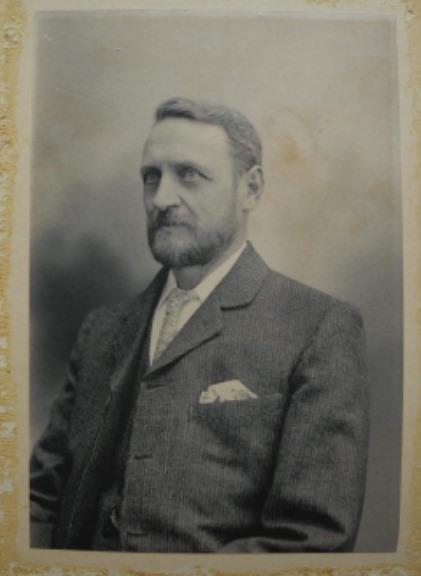
Mary Ann’s parents were George Purdy of Eastwood, and Catherine Housley of Smalley.
Catherine Housley 1849-1884, Mary Ann’s mother:
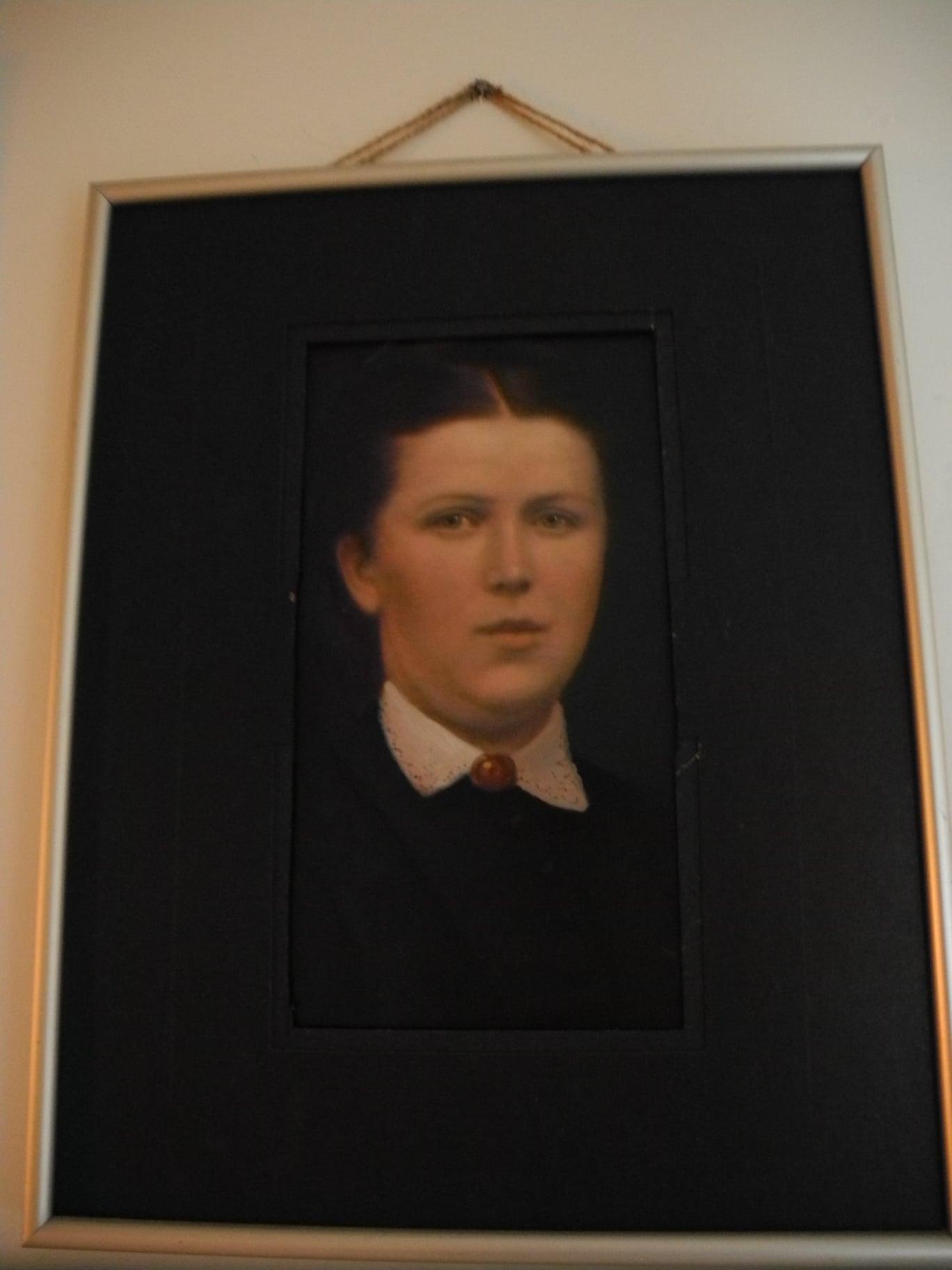
Mary Ann was four years old when her mother died. She had three sisters and one brother. George Purdy remarried and kept the two older daughters, and the young son with him. The two younger daughters, Mary Ann and Nellie, went to live with Catherine’s sister, also called Mary Anne, and her husband Samuel Gilman. They had no children of their own. One of the older daughters who stayed with their father was Kate , whose son George Gilman Rushby, went to Africa. But that is another chapter.
George was the son of Francis Purdy and his second wife Jane Eaton. Francis had some twenty children, and is believed in Eastwood to be the reason why there are so many Purdy’s.
The woman who was a mother to Mary Ann and who she thought very highly of, her mothers sister, spent her childhood in the Belper Workhouse. She and her older sister Elizabeth were admitted in June, 1850, the reason: father in prison. Their mother had died the previous year. Mary Anne Housley, Catherine’s sister, married Samuel Gilman, and looked after her dead sisters children.
Mary Ann Gilman Purdy Marshalls recipes written on the back of the Gilmans Grocers paper:
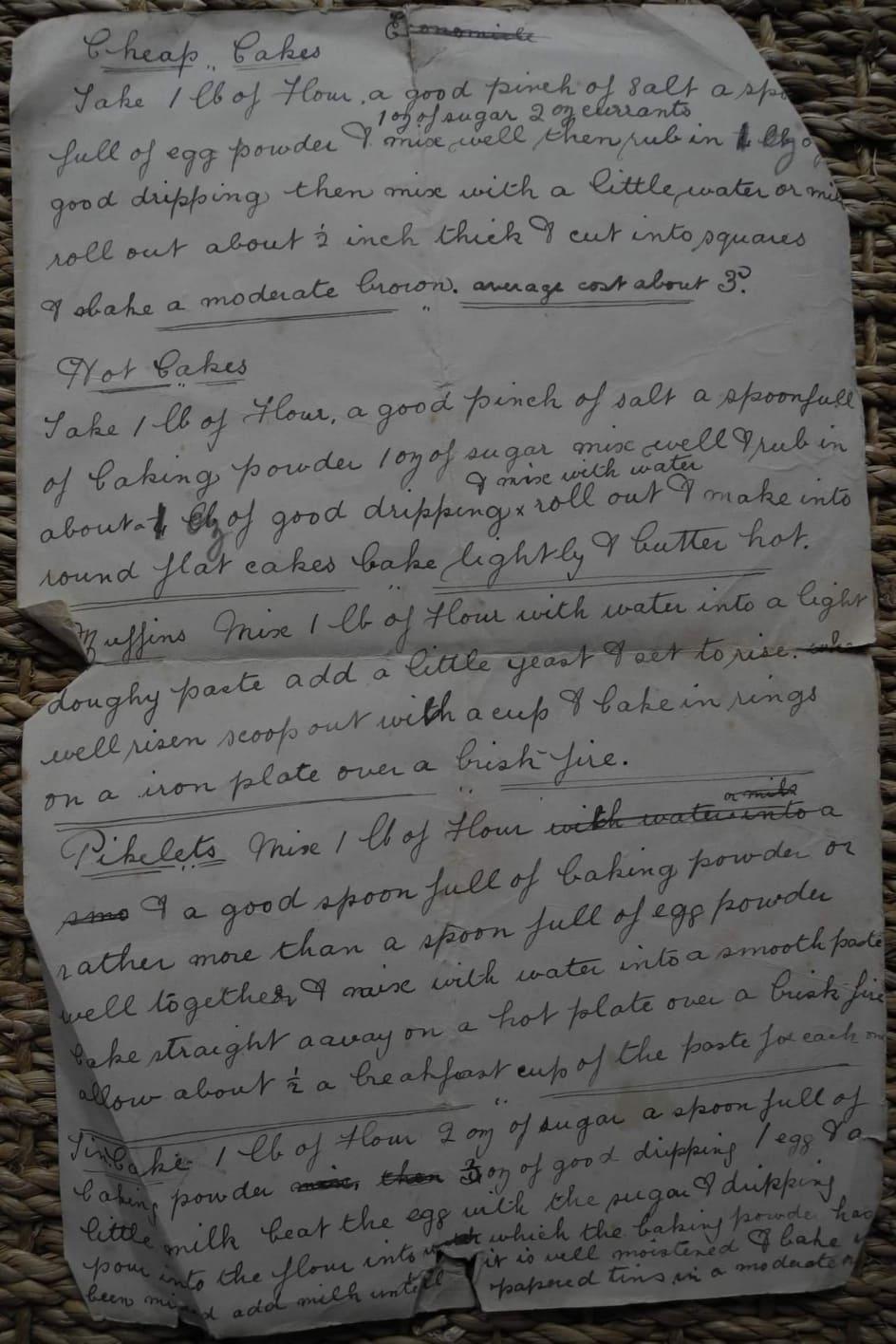 December 13, 2021 at 10:09 am #6219
December 13, 2021 at 10:09 am #6219Topic: The Elusive Samuel Housley and Other Family Stories
in forum TP’s Family BooksThe following stories started with a single question.
Who was Catherine Housley’s mother?
But one question leads to another, and another, and so this book will never be finished. This is the first in a collection of stories of a family history research project, not a complete family history. There will always be more questions and more searches, and each new find presents more questions.
A list of names and dates is only moderately interesting, and doesn’t mean much unless you get to know the characters along the way. For example, a cousin on my fathers side has already done a great deal of thorough and accurate family research. I copied one branch of the family onto my tree, going back to the 1500’s, but lost interest in it after about an hour or so, because I didn’t feel I knew any of the individuals.
Parish registers, the census every ten years, birth, death and marriage certificates can tell you so much, but they can’t tell you why. They don’t tell you why parents chose the names they did for their children, or why they moved, or why they married in another town. They don’t tell you why a person lived in another household, or for how long. The census every ten years doesn’t tell you what people were doing in the intervening years, and in the case of the UK and the hundred year privacy rule, we can’t even use those for the past century. The first census was in 1831 in England, prior to that all we have are parish registers. An astonishing amount of them have survived and have been transcribed and are one way or another available to see, both transcriptions and microfiche images. Not all of them survived, however. Sometimes the writing has faded to white, sometimes pages are missing, and in some case the entire register is lost or damaged.
Sometimes if you are lucky, you may find mention of an ancestor in an obscure little local history book or a journal or diary. Wills, court cases, and newspaper archives often provide interesting information. Town memories and history groups on social media are another excellent source of information, from old photographs of the area, old maps, local history, and of course, distantly related relatives still living in the area. Local history societies can be useful, and some if not all are very helpful.
If you’re very lucky indeed, you might find a distant relative in another country whose grandparents saved and transcribed bundles of old letters found in the attic, from the family in England to the brother who emigrated, written in the 1800s. More on this later, as it merits its own chapter as the most exciting find so far.
The social history of the time and place is important and provides many clues as to why people moved and why the family professions and occupations changed over generations. The Enclosures Act and the Industrial Revolution in England created difficulties for rural farmers, factories replaced cottage industries, and the sons of land owning farmers became shop keepers and miners in the local towns. For the most part (at least in my own research) people didn’t move around much unless there was a reason. There are no reasons mentioned in the various registers, records and documents, but with a little reading of social history you can sometimes make a good guess. Samuel Housley, for example, a plumber, probably moved from rural Derbyshire to urban Wolverhampton, when there was a big project to install indoor plumbing to areas of the city in the early 1800s. Derbyshire nailmakers were offered a job and a house if they moved to Wolverhampton a generation earlier.
Occasionally a couple would marry in another parish, although usually they married in their own. Again, there was often a reason. William Housley and Ellen Carrington married in Ashbourne, not in Smalley. In this case, William’s first wife was Mary Carrington, Ellen’s sister. It was not uncommon for a man to marry a deceased wife’s sister, but it wasn’t strictly speaking legal. This caused some problems later when William died, as the children of the first wife contested the will, on the grounds of the second marriage being illegal.
Needless to say, there are always questions remaining, and often a fresh pair of eyes can help find a vital piece of information that has escaped you. In one case, I’d been looking for the death of a widow, Mary Anne Gilman, and had failed to notice that she remarried at a late age. Her death was easy to find, once I searched for it with her second husbands name.
This brings me to the topic of maternal family lines. One tends to think of their lineage with the focus on paternal surnames, but very quickly the number of surnames increases, and all of the maternal lines are directly related as much as the paternal name. This is of course obvious, if you start from the beginning with yourself and work back. In other words, there is not much point in simply looking for your fathers name hundreds of years ago because there are hundreds of other names that are equally your own family ancestors. And in my case, although not intentionally, I’ve investigated far more maternal lines than paternal.
This book, which I hope will be the first of several, will concentrate on my mothers family: The story so far that started with the portrait of Catherine Housley’s mother.
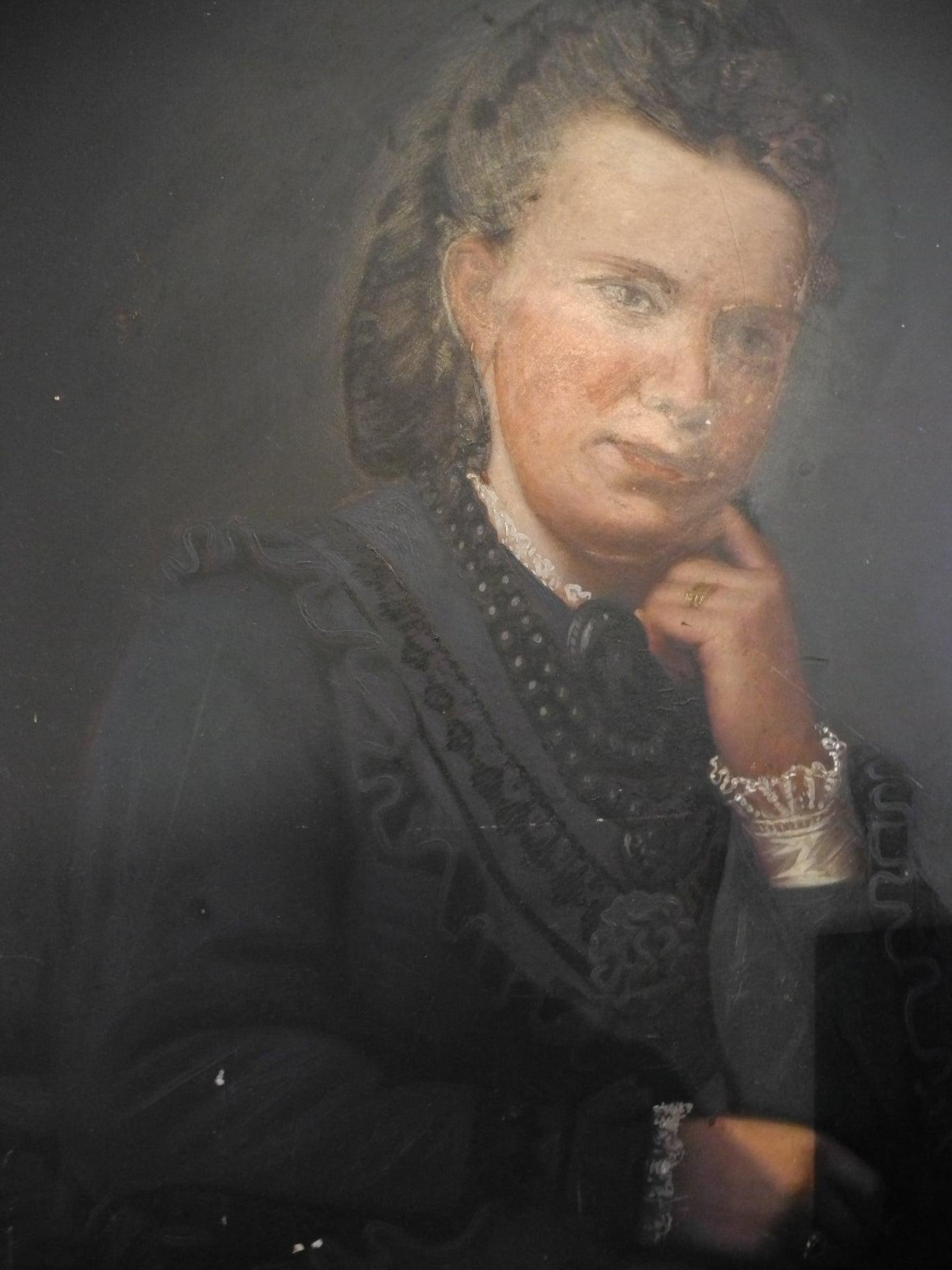
This painting, now in my mothers house, used to hang over the piano in the home of her grandparents. It says on the back “Catherine Housley’s mother, Smalley”.
The portrait of Catherine Housley’s mother can be seen above the piano. Back row Ronald Marshall, my grandfathers brother, William Marshall, my great grandfather, Mary Ann Gilman Purdy Marshall in the middle, my great grandmother, with her daughters Dorothy on the left and Phyllis on the right, at the Marshall’s house on Love Lane in Stourbridge.
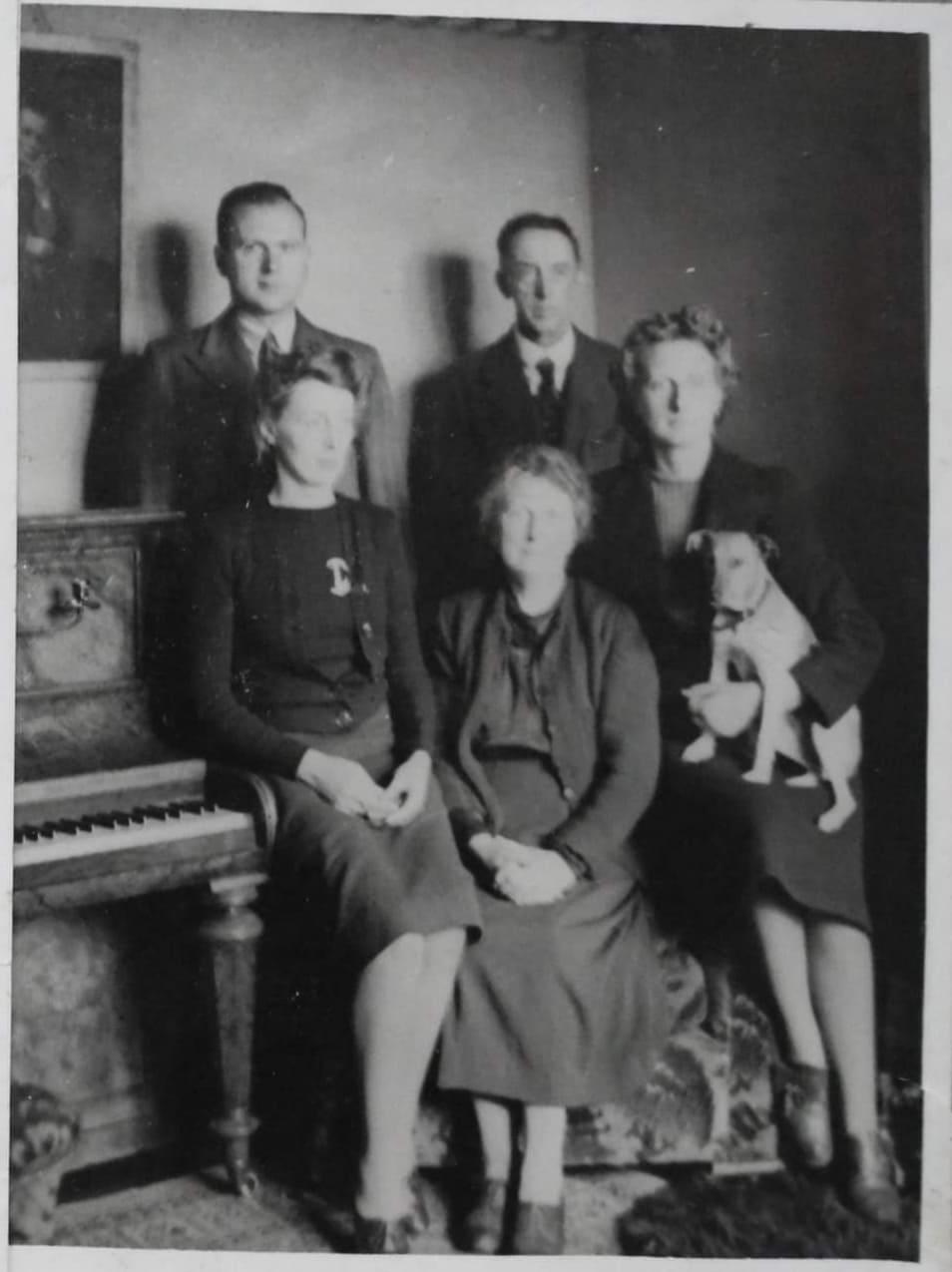
The Search for Samuel Housley
As soon as the search for Catherine Housley’s mother was resolved, achieved by ordering a paper copy of her birth certificate, the search for Catherine Housley’s father commenced. We know he was born in Smalley in 1816, son of William Housley and Ellen Carrington, and that he married Elizabeth Brookes in Wolverhampton in 1844. He was a plumber and glazier. His three daughters born between 1845 and 1849 were born in Smalley. Elizabeth died in 1849 of consumption, but Samuel didn’t register her death. A 20 year old neighbour called Aaron Wadkinson did.

Where was Samuel?
On the 1851 census, two of Samuel’s daughters were listed as inmates in the Belper Workhouse, and the third, 2 year old Catherine, was listed as living with John Benniston and his family in nearby Heanor. Benniston was a framework knitter.
Where was Samuel?
A long search through the microfiche workhouse registers provided an answer. The reason for Elizabeth and Mary Anne’s admission in June 1850 was given as “father in prison”. In May 1850, Samuel Housley was sentenced to one month hard labour at Derby Gaol for failing to maintain his three children. What happened to those little girls in the year after their mothers death, before their father was sentenced, and they entered the workhouse? Where did Catherine go, a six week old baby? We have yet to find out.
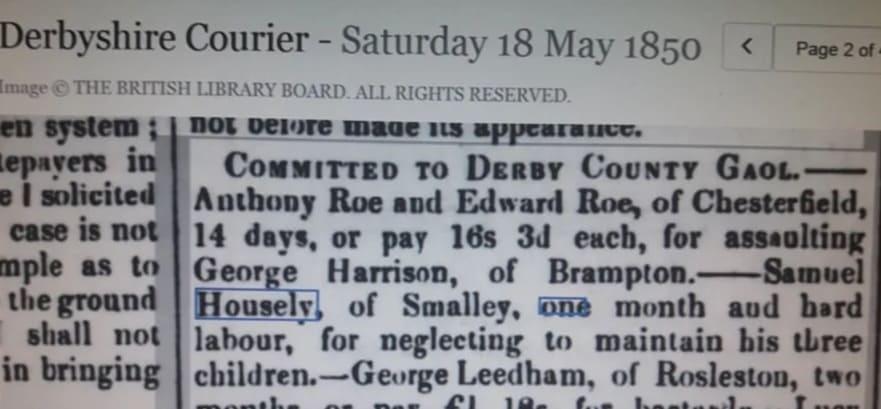
And where was Samuel Housley in 1851? He hasn’t appeared on any census.
According to the Belper workhouse registers, Mary Anne was discharged on trial as a servant February 1860. She was readmitted a month later in March 1860, the reason given: unwell.
Belper Workhouse:
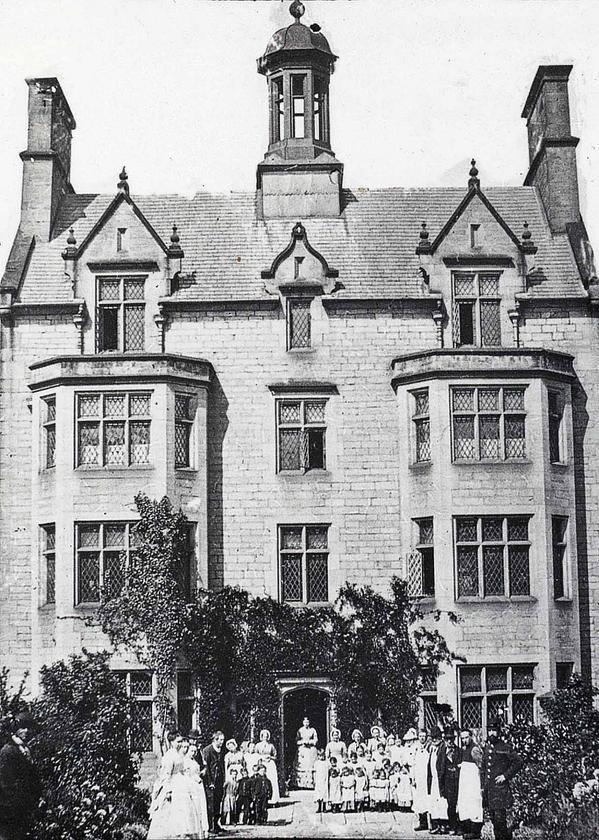
Eventually, Mary Anne and Elizabeth were discharged, in April 1860, with an aunt and uncle. The workhouse register doesn’t name the aunt and uncle. One can only wonder why it took them so long.
On the 1861 census, Elizabeth, 16 years old, is a servant in St Peters, Derby, and Mary Anne, 15 years old, is a servant in St Werburghs, Derby.But where was Samuel?
After some considerable searching, we found him, despite a mistranscription of his name, on the 1861 census, living as a lodger and plumber in Darlaston, Walsall.
Eventually we found him on a 1871 census living as a lodger at the George and Dragon in Henley in Arden. The age is not exactly right, but close enough, he is listed as an unmarried painter, also close enough, and his birth is listed as Kidsley, Derbyshire. He was born at Kidsley Grange Farm. We can assume that he was probably alive in 1872, the year his mother died, and the following year, 1873, during the Kerry vs Housley court case.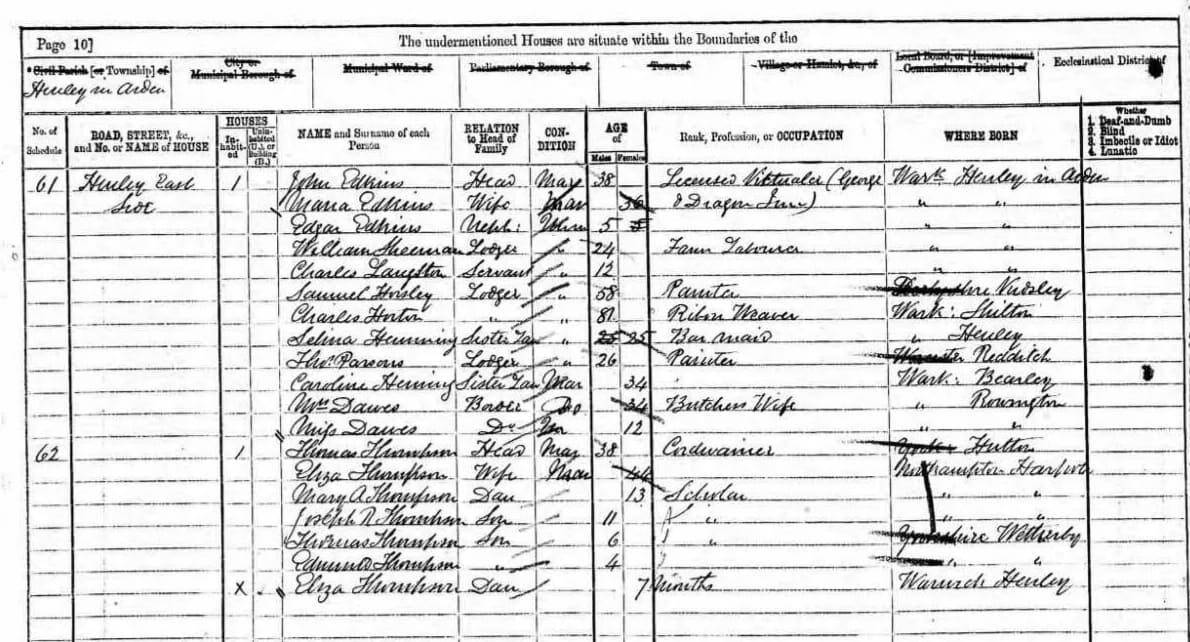
I found some living Housley descendants in USA. Samuel Housley’s brother George emigrated there in 1851. The Housley’s in USA found letters in the attic, from the family in Smalley ~ written between 1851 and 1870s. They sent me a “Narrative on the Letters” with many letter excerpts.
The Housley family were embroiled in a complicated will and court case in the early 1870s. In December 15, 1872, Joseph (Samuel’s brother) wrote to George:
“I think we have now found all out now that is concerned in the matter for there was only Sam that we did not know his whereabouts but I was informed a week ago that he is dead–died about three years ago in Birmingham Union. Poor Sam. He ought to have come to a better end than that….His daughter and her husband went to Birmingham and also to Sutton Coldfield that is where he married his wife from and found out his wife’s brother. It appears he has been there and at Birmingham ever since he went away but ever fond of drink.”
No record of Samuel Housley’s death can be found for the Birmingham Union in 1869 or thereabouts.
But if he was alive in 1871 in Henley In Arden…..
Did Samuel tell his wife’s brother to tell them he was dead? Or did the brothers say he was dead so they could have his share?We still haven’t found a death for Samuel Housley.
November 5, 2020 at 1:46 pm #6145In reply to: Two Aunties au Pair and Their Pert Carouses
The moving lorry had been parked outside the Beige House for hours.
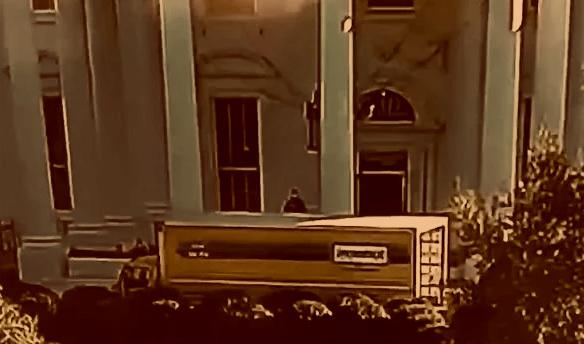
The driver was furious, as nobody has been able to answer their calls or guide them. At least the manager had let them park in front of the entrance, but it might have been based on a misunderstanding. “That’s for the removal of the Lady’s stuff, is it?” He’d nodded, it was only half a lie, his client was a lady, except she wasn’t moving out. She was moving in.
He shouted to his partner who was smoking outside.
“George! Bloody hell, if this Ms June isn’t picking up the phone or showing up, I’m going to dump all her stuff here, I don’t care how precious is her cargo!”
“Come on, Fred! Don’t get mad, you’ve seen how particular she was when we loaded the boat’s content, so full of her sentimental knick-knacks!”
“What do you expect? Us keeping all these stone statues that weigh a ton! I don’t care. I tell you, she better show up in the next minutes, or else…”
May 26, 2020 at 3:50 pm #6089In reply to: The Precious Life and Rambles of Liz Tattler
“What’s with the lucha libre mask, Bronkel?” Godfrey asked as he ushered the short tense man in the living room. “I’m not sure that’s very sanitary… Protects everything but the mouth…”
Bronkel didn’t feel like answering and at once asked for Elizabeth Tattler.
“… and don’t tell me she’s got another pitiful excuse for not delivering! Listen, she’s just the worst! And let me tell you that I’m not exaggerating. I’m also managing GRRAOU —yes, George fucking R.R.A.O. Urtin, and this guy’s been at his pentalogy since 25 years. So, I got my fill about lame excuses.”
“Her readers are devotees, you know. They know hers is a difficult craft. Warping and woofing words around like she does, so gloriously. Everybody but you Bronkel seem to understand that it’s not commonplace, it’s a treasure earned with patience and devotion.”
“Devotees for sure. They have a saint’s patience I can grant you that, and luckily for her!” Bronkel drank the inch of gin bottoms up. “And where is she, by the way? Will she not deign face me?”
“Oh, I think she’s err… busy at the moment. She’s rehearsing a scene from her last book for accuracy… with the gardener.”
August 1, 2019 at 6:32 pm #4738In reply to: Newsreel from the Rim of the Realm
“Perhaps it’s an anagram,” Ricardo ventured tentatively, “Look: INNFOODAWFUL is an anagram of “I found lawn of”, see?” He cleared his throat nervously, demoralized by the agitated energy in the room. Everyone was looking at him expectantly, so he bumbled on: “All we need to do it work out the rest…”
Exasperated looks were exchanged around the room, making Ricardo feel a fool. He was just about to excuse himself for a trip to the lavatory to wring his hands in private (hangovers always had that effect on him), when Miss Bossy tart herself piped up excitedly, “Wait a minute, by George I think he might be on to something!”
Sophie cast a skeptical eye in her direction, as Ricardo plopped back down in his chair with an audible sigh of relief. He reached for his water bottle with a trembling hand and took a swig. God, his mouth was dry.
“AHOYSICKICONGRIN is “shack in Congo!” the Boss Tart continued. “Of course!” she said, slapping her forehead.
Ricardo tittered.
September 11, 2014 at 8:16 am #3514In reply to: The Precious Life and Rambles of Liz Tattler
“You know what, Godfrey? I could just happily populate imaginary towns and then leave them all to get on with it, you know what I mean? I could call myself The Populator. My George, I think I’ve found my forte.”
“Well, you are known for an unbridled passion for introducing new characters that nobody understands, Liz.”
“Exactly!” she replied happily.August 26, 2014 at 7:09 am #3483In reply to: Get your Drag Team Queer
Bullet-proofed Summary of the latest instalments of the Abalone adventures
Most of the key characters find themselves mysteriously drawn to the ancient Temple, a place of power forgotten by most. There, many experience under a form or another the presence of the sphinx / Rene a mysterious presence left as a Guardian of the Temple by the ancient builders of the place.
- Gwinnie – learning and remembering how to communicate with others, she subtly lead them, via mediations and meditations to the secret location of the Temple. Although some split into their own projections, she manages to go through, accompanied by George, as she was infused with the Island’s energies due to her prolonged stay in the bog. She also grows and blossoms to a woman of her natural age, and later helps reconstruct Abalone with the help of George and Rene, whom she heals.
- King Artie / George – He remembers his intent and forgotten memories which were repressed and manipulated by the P’hope through his travel following Arona into her adventure. He reacquaints himself with Gwinnie, and together they lead the reborn Island.
- Irina and Mr R – Initially planning to bring Gwinnie back to Karmalott, her plan changes due to the wilting of the beanstalk. Instead, she and her travelling companions find themselves drawn to the temple by the promise of an escape off the Island, via teleportation stone boxes. Instead, she meets the sphinx / Rene who guides her through her memories. It helps heal her past, and provides her with a plausible disappearance that the Chinese corporation that she escaped from a long time ago with Mr R, would believe. Next, she goes with a more humanoid and self-aware Mr R to Mars in 2121.
- Arona – She stumbles upon the company of Irina, and recognize Gwinnie as the one she is supposed to deliver secretly to Karmalott. However, the beanstalk’s debacle they experience during a guided meditation puts a stop to her plans, and gives her a new goal. Find the spirit turtle and the mysterious Cup that can promise her to astral.
After a quest through the undercurrents with Mandrake, and still guided by the sabulmantium, she finally finds the Cup and prepares for her next adventures into the astral. - Jeremy / map dancer – He reappears naked from his escape in the midst of Irina’s team with Max his cat. They follow the team to the Temple. Little is known yet of his fate.
- Cheung Lok (and the Chinese squad) – He escapes the destruction of Gazalbion’s walls where he was detained, and use an elephant to track Sanso, who is actually Lazuli who throws him off track. He ends up teaming up with Berberus, the assassin despatched by the P’hope to track down who he believes is the culprit for the beliefs destruction. Later, he rescues Fanella from an accident of duck hovercraft, and they all enter the Temple on the tracks of the others. Thanks to Rene, Mr R and Irina, he realizes he cannot be really free, and agrees to let go of his memories, his mission and start anew on the new Island. Other members of his squad are offered to be sent back with altered memories of his demise, or to stay back as a teenager on the Island.
- Jube / The P’hope – After a last ditch effort to rescue the city, he orders its evacuation, through storks, cranes and descent through the beanstalk. He goes his own way, ready to confront the power lurking in the Temple that he avoided carefully and tried to contain many years ago. His fate is unclear but it is hinted that he was offered a similar choice as Cheung Lok, and has accepted to become an adolescent again, forgetting the bad choices he made.
- Berberus – The assassin dispatches of the management of Gazalbion during his visit there looking for clues as to the disturbances. It only hastens the descent into chaos, while during a stand-off with Sanso, he is disarmed by a tiger slug. His fears get the better of him as he is confronted with them once more inside the temple.
- Karmalott’s gents – It is believed most managed to escape the crumbling city into a refuge, where they started to rebuild anew, thanks to the leadership of George and Gwinnie.
- Gazalbion’s gents – formerly dissidents of the P’hope’s order, and later home for refugees of all times and spaces, they also mostly escaped to safety and are in the process of enriching the beliefs blueprints of the Island under the guidance of George and Gwinnie.
- Fanella (Fanetta) – Ejected brutally off a shapeshifting giant and careless duck Lazuli, she has visions of the sphinx, and seems to find herself deeply attracted to him. It is believed she hasn’t forgotten her friends in time 2020 at the village and visit them from time to time with her new pair of wings that George offered to her.
- Lazuli, Lisa, Sanso – Little is know of what happened after they reached the tile factory and then the Bay of beliefs.
- Jack (and the others at the 2020 village) – Little is known of what happened after Jack tried to teleport themselves with an amateur rescue team to the Island that Sanso had disclosed the location previously on a map. It is believed everyone who wanted was allowed to go back to the village or to any other place and time they did fancy.
- Sha, Glo, Mavis – Believed still under a very long death transition, they project to the Island, where they bump into Fanella and her new duties as a sphinx. She leads them to a new incarnated life of their chosing.
August 23, 2014 at 1:29 pm #3476In reply to: The Time-Dragglers’ Extravaganzas
The layer of clouds that had been covering Abalone for so many years had cleared up in no time. So much had changed since they went through the labyrinth of time in the old temple three weeks ago. Karmalott and Gazalbion were no more. The giant beanstalk had simply disintegrated after the mass beliefs that kept it standing were reconfigured, and Karmalott had fallen on its land counterpart. It was hard to tell one from the other when they first came back to the place.
Gwinnie looked at the giant storks nesting on the cliffs of the sea of beliefs. Her heart bloomed, she felt appreciation and gratitude over Abalone’s Nature. She had spent so many years in the bog that it had infused her with the wisdom of the island. She had been able to go unharmed through the corridors of time, because she simply knew whenre to go.
As soon as they entered the Lion mouthed door, she had taken George’s hand and whispered : follow me and you’ll be safe. That man was so trusting in life and he had such a pure heart that he did as she said. He’d told her afterward that despite all the images and illusions, his mind was focused on the green light in his heart.
When they arrived in the central room of the pyramid, she had changed. Her skin was still green, but she had found in the corridors the years she had lost in the bog.
They had decided to stay and make a fresh start. The former King of Karmalott was now helping with the reconstruction of the entire island. With his natural leader talent, he’d been creating pooling teams of magi and non-magi for different tasks : clearing the ground of the fallen cities, regrouping the lost souls, soothing the injured and building the new transitional Spas. With Gwinnie’s innate knowledge of Abalone and his innate trust, they could do marvels at bending beliefs and reality.
Actually, the transitional spa was Rene and Fanella’s idea. The two of them had been very helpful, especially since Gwinnie had repaired the sphinx. He was created to guard the temple and warn people who wanted to enter the labyrinth of time with an enigma. The corridors of time were not for the faint of heart, but to help people contact their inner knowledge to grow past their fears and blockages. What his creators had not foreseen was their own departure of the island. Rene was attached to the temple and left behind as they took no material possessions with them.
His flaw was that he needed people, and as no one was coming anymore, with time he became obsessed with the idea of making new friends. Forgetting his other duties and his connection to the timeline of Abalone, his obsession leaked and the island was thrust through time and space, intersecting with earth reality at specific dates and places. It was becoming more and more difficult to control it and the bogs anomalies were becoming harder to contain.
Fanella simply recognized Rene as the tall ebony man in her vision. She told them the yellow man, that had saved her from drowning, had disappeared quickly as soon as they entered the labyrinth, but the hook-legged man had seized her and they were caught in the most horrid nightmares. She was saved because his hook got stuck in a tiger slug pit. Rene swore he had nothing to do with it, although it was clear he had a soft spot for the young maid.
A week after they got out of the labyrinth, the girl had come to Gwinnie in the Garden of El Refugio. The green woman was helping with the introduction of new species of plants to Abalone’s circle of life.
“What is this plant ? “, asked Fanella.
“It is an okra. I’ve found it in the memories of one of the recently disengaged person from Earth.”
“The fruit has such an unusual shape.”
The silence that followed lasted for a few minutes. Gwinnie was focused on establishing a fulfilling symbiotic relationship between the plant and the island ecosystem, transforming one to acclimate the other and vice versa.
“How are your friends ?” asked the green woman.
“My friends ? Oh! They are good. Enjoying the spa and the new attractions.”
It was clear the young person had something in mind. Her loving glances to the sphinx during the last week had made it clear to everyone. The girl finally blurted it out.
“You know, Rene,” Fanella blushed as she said the name, “with the recent arrivals of transitioners, he’s got a lot of work for just one sphinx.”
“Oh! I’m sure he’s going to be just fine with that.”
“Yes, but, you know he’s been alone for such a long time.”
“Yes, Fanella?” Gwinnie stopped to look at the girl. She seemed frail, but she had this inner strength that helped her cross time and space before she ever came to Abalone.
“I want you to make me a sphinx so that I can be with Rene.” She said that without blushing, but pink colored her cheeks at the mention of the name.
If Gwinnie ever had a doubt of being in transition, it was dissipated. Her surprise almost broke the delicate connection of the okra with the island.
Becoming a sphinx wasn’t a trivial request. They still had to discuss about it, of course, and when it was obvious it wasn’t just a passing fancy, Fanella was granted her wish.
As a sphinx-wedding gift, George gave her his wings.
“They are robust and will serve you well”, he told her.August 20, 2014 at 2:39 pm #3467In reply to: The Time-Dragglers’ Extravaganzas
“Look”, said Arona, “the mist is clearing. It worked.”
“How exciting”, said Mandrake struggling with a yawn.
“Let’s go then”, said George.
Mandrake yawned again.
“What’s wrong with you ?” asked Arona.
“There seem to be a slight rise of air pressure which explains the opening”, said the robot.
“Ah.” She had no idea what the machine was talking about but didn’t want to appear ignorant.
“Thank you Mr R.” said Irina.
“You’re most welcome, Madam.”They packed their stuff and followed the path. The increase of pressure seemed to mostly affect the cats yawning repeatedly, and Greenie who had a headache. George was helping her go forward, concern showing on his face. Jeremy was carrying Max in his arms protectively.
When they arrived on the other side of the wall, they saw a heap of feathers, beak and legs which must have been a bird at some point. Jeremy felt Max stiffen in his arms, but he soon relaxed as it was not moving. At last, he had stopped yawning. They moved passed the pillars toward a small rotunda
“There! That’s the way in”, announced Jeremy. Irina gave him a sidelong glance. The rotunda was build on the lake, no solid base, just water. She didn’t want to get wet.
“The pyramid is huge”, said George.
“My sensors indicate that what you see is only the tip of the iceberg, if I may use this comparison, the edifice is going down to the bottom of the lake.“Welcome to you all, this day of your time!”
They jumped like one and turned round to see who had just talked.
“What’s that… creature ?” asked Arona. She had seen her lot of glukenitch, grizzard and langoat on her journeys, but this time she felt at loss for words.
“It is a sphinx”, stated Gwinie.
“It looks like a gay zebra looking for a fix”, said Irina.
“I’m Rene the unicorn. Are you my friends ?”
“I think it’s broken”, added the green girl, stretching out her hand. Irina looked at the child, the girl really had a funny way to put things sometimes.
“Machines get broken”, explained the Russian, “gay junkie zebras… are cracked or maniac.”
“I think she means it’s the guardian of the threshold”, said Jeremy, “but I don’t know what she means by it’s broken.”
“There doesn’t seem to be anything or anyone here”, stated Mr R. “Apart from an electromagnetic disturbance.”
“We are your friends”, said George on an impulse.
“They are my friends ! They are my friends !” Rene was bouncing around with glee. “Come on, follow me into the labyrinth. Another friend is awaiting us for his bird day party.” The sphinx jumped into the water. A vortex began to form under the rotunda, and soon became a tunnel plunging straight down the bottom of the lake.“Follow the undercurrents”, shouted Jeremy diving in the hole with Max.
“Shouldn’t we be a bit more cautious ?”, inquired Arona. “That sphinx didn’t look quite normal.”
“What’s normal here ?” asked George before following in the map dancer’s step with the others.
“I think we don’t want to stay here alone”, said Mandrake. He bounced out off her arms and trotted to the rotunda hole. “There is a column of air to slow down the fall. Are you coming ?”
Arona rolled her eyes, picked up the cat and plunged into the dark hole.August 17, 2014 at 10:48 am #3453In reply to: The Time-Dragglers’ Extravaganzas
The mirage was no longer a fleeting evasive picture.
They could see the pyramid’s top quite clearly, drawing them to its spot. By the robot’s estimation, they should already have reached it two days ago.
But it stood there, unmovable, and somehow still out of reach, an always moving horizon line.“May I suggest a drumming session?” Jeremy asked around the campfire.
Arona raised her head silently but intrigued. The rude cat jumped on a flat stone and questioned him “What do you know about drumming, young boy?”
“Well, obviously that place is protected from intrusion, and we have to find the key to its entrance. I found drumming can help align our intents and give us inner clarity. Maybe one of us will find clues.”It took them some time to discuss about technicalities, assemble a drum with a piece of Arona’s cape, and silence out their chatters, but after an unmeasurable and undetermined amount of time, they were all drawn into a pridanic journey to the rainbow world.
When they came out of the trance, Jeremy looked at them, amazed and excited by what he had seen.
First, they had travelled, guided by a herd of unicorns, to the heights of Karmalott, only to find it deserted, with faceless spirits leaving it.
When they shared their accounts, it seemed they all had seen in some form, the old City descending, with the wilting beanstalk bearing its weight with increasing difficulty. A flight of storks guided many to a safe place, and they’d seen most people would be fine.It was then that they saw the P’hope mounted on a creature flying awkwardly like a bat, descending towards the pyramid. Greenie recognized him and with him painful feelings of betrayal came back. George as well remembered old secrets, and why he was the King, and how his departure had precipitated Karmalott’s fate.
As for Irina, riding on a spirit zebra, she’d found that people from her past were after her and her dear Mr R, and had followed her on the island. Using the teleporting boxes of the temple could send her to a safe place. Maybe on one of Mars’ posts.
Arona realized, there was little hope she could claim her bounty, as there was no longer a City to bring Greenie back to. But then, a spirit tortoise showed her the Cup she was promised was lying deep in the underground clear lakes under the temple.Jeremy was quick to point it out. “That’s it! The entrance is from below, we have to follow the underground currents.”
August 14, 2014 at 6:40 am #3442In reply to: The Time-Dragglers’ Extravaganzas
The P’hope could be seen everywhere: leading the Builders to work double shifts to strengthen the collapsing structures of the flying City, exhorting the Magi to contain the failing beliefs of people back to virtuous resilience by ways of special masses held throughout Karmalott, and ensuring with the Sentries that all tremors of civil unrest was properly contained and the ring leaders properly admonished into good conduct.
The situation at the secret political prison known as Gazalbion was alarming. With most of the dangerous interlopers free to roam Abalone, and no walls to contain new prisoners, it could take a while to rebuild its walls, and the P’hope didn’t have the luxury of time on his side. It meant that no civil and belief dissidents could be brought there at the moment, and any spark of disobedience could spread like wildfire.
The P’hope dreaded what could happen if, despite all the efforts, the beanstalk was beyond repair. He knew his faltering belief in it could only hasten its fate, but even so, he wanted to be ready for the worst.
Considering the limited amount of rescue storks which were available off the walls of the city, it was likely that the result would be of apocalyptic proportion. Nevertheless, he refused to consider evacuating for the moment, even knowing it would take days for those on foot to climb down the bean’s tendrils.
Especially, as he was now in the perfect position to be the hero of the day.…
He had been robbed of his share of light many, many years ago.
At the time, a young boy had arrived from the sea and from an outside world to Abalone. Jube, who was not yet the P’hope, was a striving leader of a group of survivors of the island. The bog’s dangerous and foggy emanations and its wild life were a threat of all instants, and he had soon realized there was strength in numbers. Many lost souls had gathered, but didn’t have the strength on their own to remain focused on a reality they wanted, a dream made reality.He, Jube the Brave, had such strength in himself. But even so, they were only less than a few dozens of men and women in the camp, and the reach of what they could create was only good enough to sustain them for short periods of time.
But the boy named George had arrived from afar, and things had changed gradually. Jube had found out pretty quickly that the boy had the great potential to bring people together, and hold their beliefs like a mighty rope made of the thinnest of strands of hair. So he had offered to mentor him, while at the same time working his words into suggestions, and shaping the boy’s future to fit his own dreams.
That’s how the beanstalk started. The first sprouts were so tiny and frail, but the more people came and believed in the leadership of the one who was to become their King, the more it grew, and lifted them above the clouds and the fog of their minds.
Years had passed, Prince George became King Artie as another suggestion of the P’hope which had the side-effect to cloak Artie from his memories. The P’hope grew in power, always in the shadows however.For a while, people were happy. Truly happy. But progress was inevitable, consciousness had to move and grow, otherwise their dream of a City would have been another foggy and soul-numbing projection of their feeble minds.
The first real threat happened when Abalone, in one of its inexplicable changes of time and space, drew to them a stranger. True to their principles, they had welcomed her, nursed her, and given her a place of choice in the Magi’s ranks despite her young age. But she could see clearly between the cracks and the varnish of order. Worse, she could see the P’hope’s intentions were not so pure.
So it become soon apparent to Jube that the young Gwinie had to disappear, and her followers had to be contained. For the sake of the great Karmalott, and to shield everyone from the impending chaos, the same chaos they had came from victorious many years ago.
He and his minions had struck in a very swift and coordinated movement. Gwinie was tragically lost in the bog during her rite of passage. A truce was arranged with her followers, and they were allowed a concession, with enough resources to survive. They ultimately built Gazalbion, which also became, in a mutual arrangement, a political prison for Karmalott, unknown to virtually everyone in the City. The Processor, one of Gwinie’s former followers, was glad to receive prisoners who would add to the strength and mass beliefs of his encampment. The P’hope in return, was glad to be rid of difficult problems.
That was so long ago, but it rang like a warning from no further than yesterday.
They had never found out what the old temple’s ruins were for, or by which civilization before them they were built. They were as old as the island itself, and seemed to be doomed, full of an ominous power he couldn’t and feared to harness. If anything else failed, he would go back there. Maybe that was his only solution.
August 14, 2014 at 1:34 am #3441In reply to: The Time-Dragglers’ Extravaganzas
Dark clouds had gathered in the sky, the temperature had dropped of several degrees, making the breeze feel colder. The group had been walking for hours in the bog toward the elusive temple. With the darkness of the clouds, its mirage had begun to fade away. Greenie had said they’d better stop when the image was gone because they could become lost.
They had managed to make a wet campfire, and were trying to get warmth from the fleeting flames.
“I had a strange dream last night”, said George to Arona who was sitting next to him.
She smiled politely, not sure she wanted to hear about the winged man dreams. She considered standing up and being rude.
“I was a teenager”, he continued, wrapping himself into his wings.
Arona rolled her eyes inwardly, looking around for help. Mandrake was sleeping under her cape.
“An island appeared one day on the coast, people thought it was an ancient magic island and feared to approach it. It was visible only for a couple of days. It was such a weird dream.”
“Maybe you should write it down”, said Arona.
“Oh! Probably not, if the P’hope gets hold of it, I have the feeling it’s not in my interest.” He grinned like a kid. “Anyway, I knew in the dream that the island was still there, it was still reachable. So one day I took my father’s boat. It was a small boat, not made to go too far from the coastline. I didn’t know, and I didn’t care. I went into the mist, completely trusting I would find this island that everybody feared. It was rising tide, and I had to fight the current pushing me to the shore. I think it’s a dream who brought me there, a dream of a girl calling me in a garden. George”
“Is that all?” asked Arona after a moment of silence from George.
“Yes, it’s most certainly a silly dream, I’ve lived in Karmalott my entire life.”
“You’ll have to work on your dream telling, pal”, said Mandrake, “the punchline is missing.”Nobody noticed how the flames of the fire were dancing into the green girl’s eyes.
August 11, 2014 at 9:16 am #3421In reply to: The Time-Dragglers’ Extravaganzas
“What? Teleportation sandpapered granite boxes in an old forgotten temple? You really want to stretch my beliefs to the point of rupture, little one”, Irina looked surprised at Greenie after their little meditative chit-chat.
The angel guy with bad tastes of clothing, who said he was named George, interrupted rudely.
“I think she’s right, it rings a distant bell. I don’t know how I know about it, but somehow getting out of Karmalott altered my memories… But I think it’s true, they were used to travel on and off the island, also to other places. Why they’ve been lost is a mystery… But they should be getting us back up to the City in no time…”
“Or out of the island…” Irina gave a look to Mr R. “Let’s find these precious ruins”.
Thanks to the sabulmantium’s information, Arona had recognized the strange travelling companions of the young girl she was supposed to find. It was no coincidence she’d dropped on that awful bog water so near to the raft. She had actually aimed for it before Mandrake panicked at the sight of the murky waters and got them both in for a swim.
She’d decided to stay with them, and reveal her purpose at an appropriate moment, while trying to keep the stranger’s hands off her butt.
She was pleased to see Mandrake was also struggling being left alone by the blinking parrot.
August 8, 2014 at 5:45 am #3400In reply to: The Time-Dragglers’ Extravaganzas
If the sabulmantium was to be trusted, the beanstalk was a tangle of many paths, and the main and easiest accesses down its dangling twirly greenish tentacles were all outside of the city walls, in a zone where some lords managed to rule pockets of mass beliefs and a bunch of unattractive mongrel mobsters.
“Sounds potential adventure material” Mandrake had had the nerve to say when they’d packed.
“No it isn’t” Arona had said.
Then with more gusto “NO IT ISN’T” as though to convince all the sleepy tarts of the nymphouse below her rented room.More doubts had sunken their claws in her tender heart, and a gulp of whatever astral cup didn’t seem in hindsight a worthy deal for all her troubles. Nonetheless, she was a woman of her word, which was probably why she wasn’t of many. Too much trouble being of all of them, whatever that meant.
“Honestly Mandrake, keeping you on track is worse than herding… dragons.”
She would have said sheep, but she wasn’t so rude yet. Mandrake could have taken that too badly, and he would again prove useful to distract the guards of the Southern Post. That’s where she decided to go, as with all the heat, it had to be the one less guarded.Indeed, when she arrived, as planned, the gate was badly manned, and sleepy soldiers where reaching for the rare spots of shadow.
She decided to make a run for it. The soldiers didn’t look very fit. She started to go, thinking about zigzagging between the air bottles littering the plaza, when she felt a tug pulling her back by the cloak, almost sending her flying off her butt.“FUCK!” she shouted as silently as she could. “You again! I thought I told you not to follow me! Mandrake, attack! Go for the balls!”
She was in a fury, but Mandrake licked his paw with a disgusted look on his face that meant “Hnhn, not going for that, sweetie. You’re on you own to herd that dragon, my lovely pooh.”
“Shhht!” the guy said with a bit smile.
“Don’t shush me, you… ninnyhammer!”
She didn’t know where the last word came from, but they sure felt good, although not quite rude enough.
“Oh, the lady is a pirate who knows her insults.” he answered with his cocky smile.
“Don’t mock me, you mooncalf”
“You were trying to sneak out, were you?”
“Why do you care, hobbledehoy?”
“The guards have aircon chain-mail and armours, see, look at those bottles on their backs… How could you beat them running with your heavy cloak?”
“Maybe Mr Snollygoster has a better suggestion?”
“Of course I have, if you care to follow me, Ms Mumpsimus.”Arona was almost speechless. Not keen on following any stranger, she asked her guts, and they seemed to have a liking for the handsome fellow. It stirred old remembrance of going with the flow tactics, and when she did actually follow him, it had absolutely nothing to do with the fact that he and Mandrake were already ahead in one of the alleys.
“Oh, no, let him have the keys to some secret tunnel, I won’t go for another sewer escape!”
As if her guardien angel has heard her secret prayer, it happened that the stranger had some strange stone key in his bag, opening a secret wall entrance.“Oh.” was all she conceded to the stranger.
Nonplussed he offered her his hand “George” he presented himself still with the same broad smile.
She took his hand haughtily, and entered the vaulted tunnel, not telling him yet her name, in case she felt like choosing a sexy and mysterious code name. She could trust no one…“Traitor” she hissed at Mandrake who was purringly looking at the strangers’ boots.
August 7, 2014 at 3:17 am #3394In reply to: The Time-Dragglers’ Extravaganzas
King Artie had decided he would be George. That would be his adventurer’s identity, his nom de plume (if he ever gets out of his adventure alive and manages to write novels out of it, that is).
He’d packed in a hurry, taking advantage of the guards’ shift at midday to disappear from the castle unnoticed.
The bag full of his stone collection was getting heavy under the sun, and the exertion took his toll and dulled his usually quick reflexes so that he was taken by surprise when the girl grabbed him. A strong woman… Now he was smitten.He’d noticed her leaving under the most peculiar of cloaks, taking her at first for a male adventurer —he had assumed being followed by a stray cat meant it was a fish-smelly adventurer too. Her gait sure wasn’t very feminine, but her face was pretty; even prettier when she looked angry was something he would have loved to tell her if she’d given him the chance.
He chose to ignore her last remark and continue to discreetly follow her. She knew her way around, and seemed headed out of town. At least she was a better bet than being under the thumb of the P’hope’s minions.
-
AuthorSearch Results
Search Results for 'george'
-
Search Results
-
The following stories started with a single question.
Who was Catherine Housley’s mother?
But one question leads to another, and another, and so this book will never be finished. This is the first in a collection of stories of a family history research project, not a complete family history. There will always be more questions and more searches, and each new find presents more questions.
A list of names and dates is only moderately interesting, and doesn’t mean much unless you get to know the characters along the way. For example, a cousin on my fathers side has already done a great deal of thorough and accurate family research. I copied one branch of the family onto my tree, going back to the 1500’s, but lost interest in it after about an hour or so, because I didn’t feel I knew any of the individuals.
Parish registers, the census every ten years, birth, death and marriage certificates can tell you so much, but they can’t tell you why. They don’t tell you why parents chose the names they did for their children, or why they moved, or why they married in another town. They don’t tell you why a person lived in another household, or for how long. The census every ten years doesn’t tell you what people were doing in the intervening years, and in the case of the UK and the hundred year privacy rule, we can’t even use those for the past century. The first census was in 1831 in England, prior to that all we have are parish registers. An astonishing amount of them have survived and have been transcribed and are one way or another available to see, both transcriptions and microfiche images. Not all of them survived, however. Sometimes the writing has faded to white, sometimes pages are missing, and in some case the entire register is lost or damaged.
Sometimes if you are lucky, you may find mention of an ancestor in an obscure little local history book or a journal or diary. Wills, court cases, and newspaper archives often provide interesting information. Town memories and history groups on social media are another excellent source of information, from old photographs of the area, old maps, local history, and of course, distantly related relatives still living in the area. Local history societies can be useful, and some if not all are very helpful.
If you’re very lucky indeed, you might find a distant relative in another country whose grandparents saved and transcribed bundles of old letters found in the attic, from the family in England to the brother who emigrated, written in the 1800s. More on this later, as it merits its own chapter as the most exciting find so far.
The social history of the time and place is important and provides many clues as to why people moved and why the family professions and occupations changed over generations. The Enclosures Act and the Industrial Revolution in England created difficulties for rural farmers, factories replaced cottage industries, and the sons of land owning farmers became shop keepers and miners in the local towns. For the most part (at least in my own research) people didn’t move around much unless there was a reason. There are no reasons mentioned in the various registers, records and documents, but with a little reading of social history you can sometimes make a good guess. Samuel Housley, for example, a plumber, probably moved from rural Derbyshire to urban Wolverhampton, when there was a big project to install indoor plumbing to areas of the city in the early 1800s. Derbyshire nailmakers were offered a job and a house if they moved to Wolverhampton a generation earlier.
Occasionally a couple would marry in another parish, although usually they married in their own. Again, there was often a reason. William Housley and Ellen Carrington married in Ashbourne, not in Smalley. In this case, William’s first wife was Mary Carrington, Ellen’s sister. It was not uncommon for a man to marry a deceased wife’s sister, but it wasn’t strictly speaking legal. This caused some problems later when William died, as the children of the first wife contested the will, on the grounds of the second marriage being illegal.
Needless to say, there are always questions remaining, and often a fresh pair of eyes can help find a vital piece of information that has escaped you. In one case, I’d been looking for the death of a widow, Mary Anne Gilman, and had failed to notice that she remarried at a late age. Her death was easy to find, once I searched for it with her second husbands name.
This brings me to the topic of maternal family lines. One tends to think of their lineage with the focus on paternal surnames, but very quickly the number of surnames increases, and all of the maternal lines are directly related as much as the paternal name. This is of course obvious, if you start from the beginning with yourself and work back. In other words, there is not much point in simply looking for your fathers name hundreds of years ago because there are hundreds of other names that are equally your own family ancestors. And in my case, although not intentionally, I’ve investigated far more maternal lines than paternal.
This book, which I hope will be the first of several, will concentrate on my mothers family: The story so far that started with the portrait of Catherine Housley’s mother.

This painting, now in my mothers house, used to hang over the piano in the home of her grandparents. It says on the back “Catherine Housley’s mother, Smalley”.
The portrait of Catherine Housley’s mother can be seen above the piano. Back row Ronald Marshall, my grandfathers brother, William Marshall, my great grandfather, Mary Ann Gilman Purdy Marshall in the middle, my great grandmother, with her daughters Dorothy on the left and Phyllis on the right, at the Marshall’s house on Love Lane in Stourbridge.

The Search for Samuel Housley
As soon as the search for Catherine Housley’s mother was resolved, achieved by ordering a paper copy of her birth certificate, the search for Catherine Housley’s father commenced. We know he was born in Smalley in 1816, son of William Housley and Ellen Carrington, and that he married Elizabeth Brookes in Wolverhampton in 1844. He was a plumber and glazier. His three daughters born between 1845 and 1849 were born in Smalley. Elizabeth died in 1849 of consumption, but Samuel didn’t register her death. A 20 year old neighbour called Aaron Wadkinson did.

Where was Samuel?
On the 1851 census, two of Samuel’s daughters were listed as inmates in the Belper Workhouse, and the third, 2 year old Catherine, was listed as living with John Benniston and his family in nearby Heanor. Benniston was a framework knitter.
Where was Samuel?
A long search through the microfiche workhouse registers provided an answer. The reason for Elizabeth and Mary Anne’s admission in June 1850 was given as “father in prison”. In May 1850, Samuel Housley was sentenced to one month hard labour at Derby Gaol for failing to maintain his three children. What happened to those little girls in the year after their mothers death, before their father was sentenced, and they entered the workhouse? Where did Catherine go, a six week old baby? We have yet to find out.

And where was Samuel Housley in 1851? He hasn’t appeared on any census.
According to the Belper workhouse registers, Mary Anne was discharged on trial as a servant February 1860. She was readmitted a month later in March 1860, the reason given: unwell.
Belper Workhouse:

Eventually, Mary Anne and Elizabeth were discharged, in April 1860, with an aunt and uncle. The workhouse register doesn’t name the aunt and uncle. One can only wonder why it took them so long.
On the 1861 census, Elizabeth, 16 years old, is a servant in St Peters, Derby, and Mary Anne, 15 years old, is a servant in St Werburghs, Derby.But where was Samuel?
After some considerable searching, we found him, despite a mistranscription of his name, on the 1861 census, living as a lodger and plumber in Darlaston, Walsall.
Eventually we found him on a 1871 census living as a lodger at the George and Dragon in Henley in Arden. The age is not exactly right, but close enough, he is listed as an unmarried painter, also close enough, and his birth is listed as Kidsley, Derbyshire. He was born at Kidsley Grange Farm. We can assume that he was probably alive in 1872, the year his mother died, and the following year, 1873, during the Kerry vs Housley court case.
I found some living Housley descendants in USA. Samuel Housley’s brother George emigrated there in 1851. The Housley’s in USA found letters in the attic, from the family in Smalley ~ written between 1851 and 1870s. They sent me a “Narrative on the Letters” with many letter excerpts.
The Housley family were embroiled in a complicated will and court case in the early 1870s. In December 15, 1872, Joseph (Samuel’s brother) wrote to George:
“I think we have now found all out now that is concerned in the matter for there was only Sam that we did not know his whereabouts but I was informed a week ago that he is dead–died about three years ago in Birmingham Union. Poor Sam. He ought to have come to a better end than that….His daughter and her husband went to Birmingham and also to Sutton Coldfield that is where he married his wife from and found out his wife’s brother. It appears he has been there and at Birmingham ever since he went away but ever fond of drink.”
No record of Samuel Housley’s death can be found for the Birmingham Union in 1869 or thereabouts.
But if he was alive in 1871 in Henley In Arden…..
Did Samuel tell his wife’s brother to tell them he was dead? Or did the brothers say he was dead so they could have his share?We still haven’t found a death for Samuel Housley.